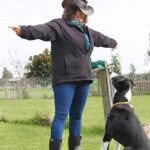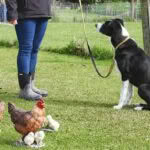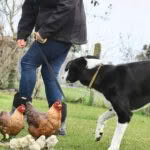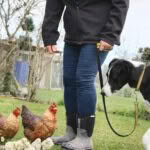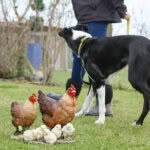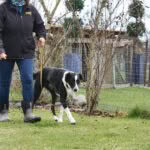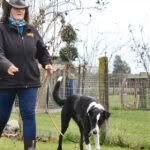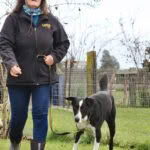How to train a dog to be friends with your chickens
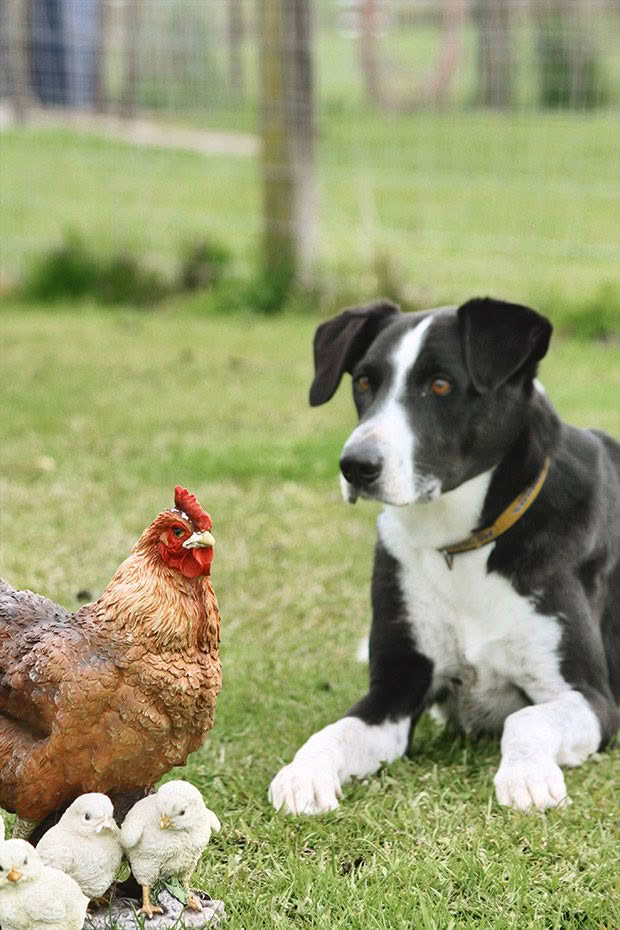
Dog trainer Christine Nielsen shares her tips for helping your dog to see your chickens as friends, not dinner.
Words: Nadene Hall & Christine Nielsen Images: Nadene Hall
Nearly all dogs are born with an innate drive to hunt prey. It’s written into their DNA to chase things. Poultry is often irresistible to a dog: they’re a small size, run or freeze when under threat, and smell and taste great.
If you have a puppy, a new dog, or you want to teach your current dog to live in peace with poultry, focus on basic training, including:
■ good manners, eg sit, wait, stay, come;
■ positive boundaries regarding all animals, eg dogs, cats, poultry, goats, sheep, cows etc.
This work is a lifelong commitment, but it doesn’t take a large amount of time, perhaps just a few minutes every few days once a dog is trained. Trainer Christine Nielsen’s recommendation is to start by practicing a few basics every day, such as coming when called, and sitting and waiting for a command before eating.

Nearly all dogs are born with an innate drive to hunt prey.
Most dogs like to have a job to keep them mentally and physically stimulated. A little extra training is an excellent opportunity to remind your dog of the behaviour you expect, and tire them out. Ten minutes of intense training, such as learning a new trick, doing agility or tracking can be just as tiring as an hour-long run-around.
BEFORE YOU BEGIN
Understand your dog’s temperament. A dog’s breed (or dominant breed) gives you useful clues as to how it may react to poultry:
■ a hunting or gun-type dog, such as a Labrador, may want to chase and grab;
■ a working dog, such as a Border collie, may try to herd and nip;
■ a non-sporting breed, such as a poodle or bulldog, may rush in and run about;
■ a terrier breed may chase and can be very quick to grab;
■ a lap dog may be scared, but there are always exceptions.
With some dogs, it’s easy; a firm ‘no’ might be all you need for your dog to know not to bother your poultry. Always be vigilant as a lapse can be fatal to a hen. It’s also more challenging to train a dog out of a behaviour once it has experienced the ‘fun’ of chasing or killing.
If you have adopted a rescue dog, try to find out its history with livestock and poultry. If you can’t, or you know the dog has had an issue with poultry or other livestock, Christine advises getting help.
“It’s often best to call in a professional trainer that understands and has knowledge of training this sort of behaviour.” It might cost you a few hundred dollars to get a series of lessons from a good trainer. It then takes regular practice to remind your dog of the rules.
General tips
■ If your dog is high energy, give it some exercise and do some basic obedience before you start training.
■ Have a plan: know what you’re going to practice, have treats and equipment ready.
■ Don’t have any other distractions around you, such as your phone or small children.
■ Keep your eyes on the dog the entire time.
Christine’s tip: Teach your dog to ‘watch’
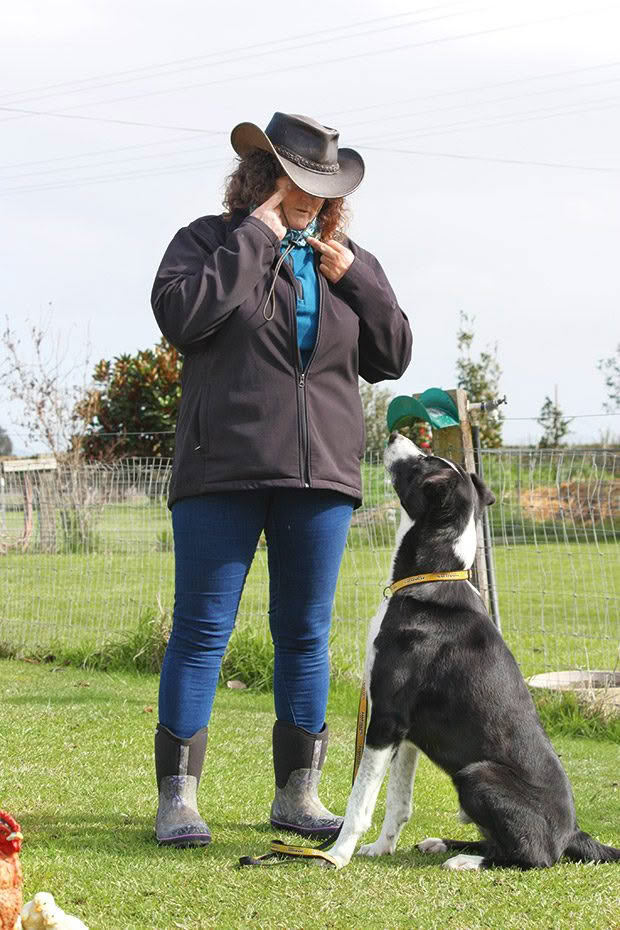
Goal: to direct your dog’s eyes to your eyes
Technique: Have your dog sit in front of you. Hide a treat in your hand and bring it up to your eyes, then say ‘watch’ in a happy tone – praise and treat as soon as your dog looks at your eyes. Only give a treat when the dog locks eyes with your eyes. It’s important to perfect this technique before you start training your dog to be around poultry. Some dogs learn quickly. Others may take more time, patience, and repetition to get it right.
Advanced technique: have treats in both hands and hold your arms out to the sides. Say ‘watch’ in a happy tone. Your dog gets treated when it locks onto your eyes.
As your dog gets better at doing this, try doing it with distractions around, so they know to always concentrate on you. Do it in different places, eg when you’re out walking, in a dog park, at the beach, in various areas of the house, garden and around your block, near to other animals (which should be behind secure fences).
The ‘watch’ bonus
The ‘watch’ command can be useful if you come across an unknown dog while out walking. Dogs stare at each other as a preliminary sign of aggression. In dog language, if one dog looks away, it’s telling the other dog it isn’t interested and isn’t a threat.
If you come across a strange dog that is still and staring at your dog, command your dog to ‘watch’ you. It will divert its gaze from the other dog, helping to reduce tensions, giving you time to turn and retreat.
Christine’s tip: Use a high-value treat food
Christine likes to use Simply Superior Chunky dog roll and Possyum when training, the only time her dogs get a soft, fatty food. Don’t use biscuits or other food you usually give them at mealtimes; it needs to be something different and very enticing, which is why dog roll is a good option. Have a supply of dog roll in a bag attached to your waist so you can quickly and easily have a treat in your hand to reward good behaviour.
USEFUL TOOLS
Slip lead ($20+)
A slip lead gives you extra security if your dog accidentally backs out of its collar. It also has a negative effect, pulling on the neck if a dog moves forward when you don’t want it too. Don’t use a slip lead to jerk on a dog’s neck.
Long line ($20-$30)
Once a dog has learned the basics, a long line allows you to work with it while you are at a distance, with the security of knowing your dog can’t chase if it gets excited. A 10m ‘lunge’ rope for a horse is a good option.
A basket-type muzzle ($50+)
A muzzle that still allows a dog to breathe easily, pant, and eat a treat and drink, gives you extra security if you’re unsure how your dog will react. It’s important to condition your dog to wear a muzzle before you begin training.
A secure enclosure for your chickens
This could be their fenced run, but you could also use something like a large dog crate on the lawn to safely hold a few chickens during training.
TRAINING YOUR DOG
Tools: slip lead, treats, secure,pen for chickens
Duration per session: 2-3 minutes (puppy), 5-10 minutes (adult)
Ideal sessions per day: 2 (puppy), 2-4 (adult)
It’s essential to remain calm and always be patient when training, especially a puppy. Don’t pressure or rush a dog. “Training works best for you and your dog if it’s fun,” says Christine. “You want to create situations where your dog can do well, not spend your time continually telling it off.”
- Mate is walked up to the ‘chickens’ and shows some curiousity.
- He is immediately told to ‘leave it’, given a little tug on the lead, and is turned away.
- Always keep real chickens in a safe enclosure. We used ‘fake’ ones for ease of photography.
Think of a short, positive training word such as ‘yes’ or ‘good’ and be ready to say it in a ‘happy’ voice, slightly higher pitched than normal. Don’t be physically high energy when you say it so you don’t over-excite your dog.
Think of a short negative word, such as ‘no’, ‘utt’, or ‘leave it’. You want to say it in a lower tone, and give a short tug on the lead as you do so to alert the dog.
You want your chickens to like your dog. Have someone feed them when your dog is around. They may become flappy and excited; always have your dog secure, but if it becomes excited too, walk it away immediately.
Tips:
■ Training should be done on a loose lead unless you are saying your negative word.
■ Don’t allow a dog near a hen with chicks.
■ Don’t ever let a dog have free access until you are 100 percent confident it isn’t going to hurt a chicken.
Step 1
Do some basic obedience such as heel, sit, wait, down, and ‘watch’ where your dog can see the chickens, but not so close that it’s distracted by them. If it shows signs of distraction, move a few metres further away and try again. Keep moving away until the dog focuses on you and training, not the chickens.
If your dog barks or tries to run towards the hens, hold the lead firmly. If you’re using a slip lead, it will pull on the dog’s neck if it moves forward. Use your negative word, turn your dog away, and walk far enough away that your dog settles. Ask it to sit, then watch, then give it a treat so you reward calm behaviour.
- Do basic obedience near your hens, but at a distance where your dog is happy to concentrate on its work.
- Here, Christine and Mate practice heeling while walking past the ‘chickens’.
When it does well, try going a metre closer and repeat. Always end a training session on a positive note. If your dog becomes distracted on your last training attempt, move it away and ask it to sit, watch, etc, so you finish with a success.
Ideally, you want to train an adult dog several times a day until it can be close to your chickens and stay calm. It might take a couple of weeks or longer. It’s best to be over-confident about a dog’s behaviour before you move on, rather than push it
too quickly and have to reprimand it.
Step 2
Try repeating your obedience training with some poultry loose in a large area like a paddock. Always keep your dog on a lead and observe it carefully, in case movement from the hens triggers a chase behaviour.
Work on your obedience training. Be calm. Keep your dog on the slip lead, even if you’re feeling very confident. Look for signs of high arousal such as barking, whimpering, puffing, jumping, or any quick, flighty movements. If your dog does anything like this, move it away and try again at a distance where it’s calm.
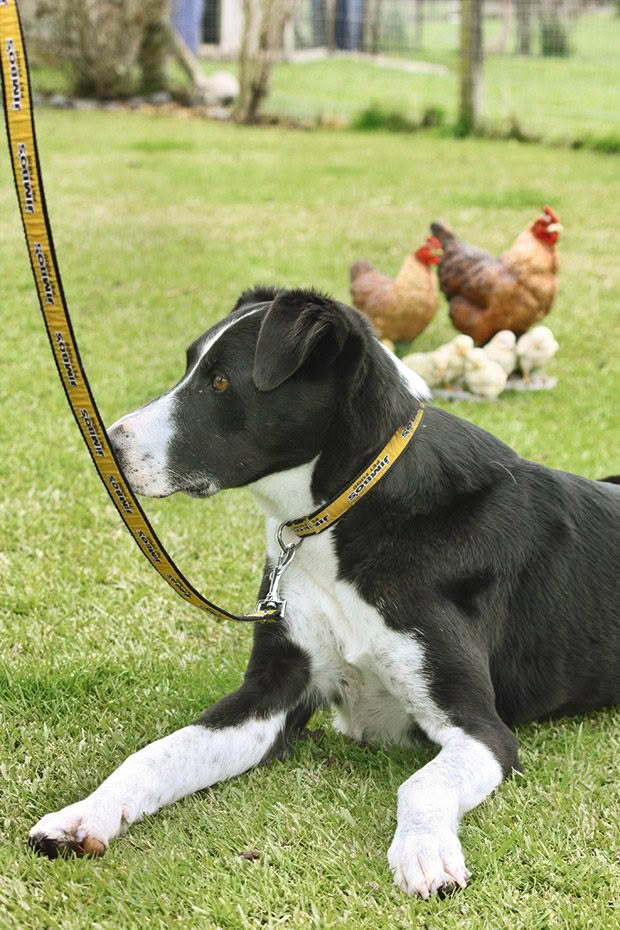
Practice commands with the dog secure on a leash. Periodically treat to reward correct behaviour.
Once your dog is doing well, you can progress to using its regular collar and lead. If your dog gets too close to the poultry, use your negative command – your dog should automatically turn away. Practice your ‘watch’ commands, so your dog remains highly focused on you, not the chickens.
Another useful command is an emergency ‘stop and down’, where a dog immediately drops into a down position no matter what it’s doing, even when running. Christine uses the command ‘drop’. Christine says this type of training takes a lot of practice to get right, and a good trainer can help you to perfect it.
Step 3
Swap the lead for the long line so you can still control your dog but be physically further away from it. Practice ‘sit’, ‘wait’, ‘down’, and an emergency drop if your dog has learned it.
If the dog shows signs of reacting to the chickens, you’re too close. One day you might do it 10m away. Another day you might need to be 15m away. It all depends on the dog and the situation.
Try practicing a negative command with something high value, like a dog’s favourite toy or a pig’s ear treat. This way, if your dog does ever try to grab at a chicken, it has practiced stopping its behaviour around something enticing.
If you’re feeling 100% positive about your dog’s behaviour, try dropping the long line, so it’s free to move. Stay close so if there’s an issue, you can immediately pick it up again. Only have your dog loose around your flock when you have perfect behaviour over several weeks. If you are not 100% confident, don’t risk it.
TRAINING DOS AND DON’TS
Do:
■ keep calm;
■ consistent repetitions;
■ set up training so it’s a happy time for you and your dog, and always end on a positive note;
■ practice obedience away from chickens first;
■ keep your chickens safe at all times;
■ supervise your dog and have it on-lead, or keep it in a secure area away from your chickens;
■ teach your dog to focus on you using a ‘watch’ command – perfect it away from your chickens;
■ teach an emergency drop and instant recall, all on lead, again, perfected away from your chickens (a trainer can help with this);
■ keep your dog on a lead at all times around livestock or chickens.
Don’t:
■ over-excite your dog or your chickens;
■ leave your dog unsupervised;
■ leave your chickens out where your dog could come into contact with them.
WHY KIWI AVERSION TRAINING MAY HELP A CHICKEN KILLER
The most well-trained dog has the potential to kill a kiwi. Even dogs certified and trained to help conservation workers find kiwi wear muzzles, just in case.
Kiwi for Kiwis is a group that helps with protection projects and education all over NZ. It recommends all dog owners who live near or go into wild kiwi areas attend specialist aversion training courses with their dog.
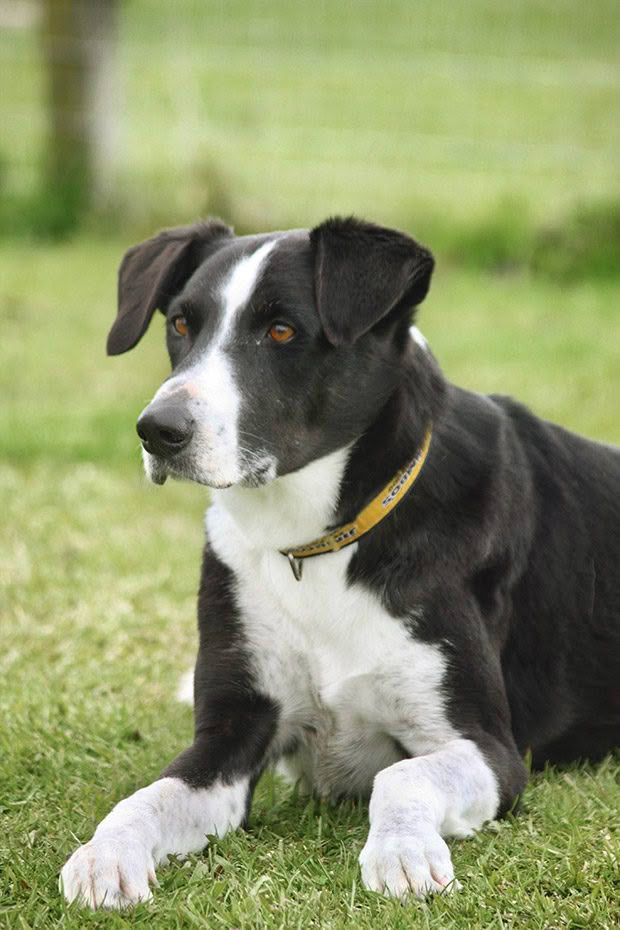
This training is something Christine recommends if a dog has chased or killed chickens, in addition to working with a professional trainer. Kiwi aversion training is a carefully designed programme with a certified trainer. Dogs are trained to avoid a series of props: a taxidermically-stuffed kiwi, a dead frozen kiwi, kiwi faecal material, a two-dimensional kiwi cut-out, and kiwi nesting material.
A very short, mild shock is delivered via a collar controlled by the trainer. To see kiwi aversion training in action, search YouTube for ‘Northern News – Kiwi aversion training’. Find a course or certified trainer near you: www.kiwisforkiwi.org
What poultry owners can learn
Arnja Dale of the RNZSPCA, and Christopher Podlesnik and Douglas Elliffe from the University of Auckland studied the 1647 sessions of kiwi aversion training (KAT) involving 1156 dogs between 1998 and 2007 at sites around the Coromandel. What they found shows some useful insight into how dogs respond to training.
Ongoing training is key
Before training began, all the dogs were interested in the kiwi training props. After the first session:
■ 60% of dogs showed strong avoidance;
■ 33% showed moderate avoidance;
■ 7% showed indifference rather than interest.
When presented with the training props at the second training session (a year later), 69% of the dogs displayed avoidance. It increased to 88% at the third training session, 86% at the fourth session, and 100% at the fifth session. If dogs didn’t get a refresher course within three years, avoidance levels fell significantly.
The research recommended dogs were trained at least annually for two years, then annually or bi-annually after that — the more regular the training, the better the dog’s behaviour.
Some dogs learn faster than others
The research found aversion training is most effective if started during puppyhood. Older dogs were more likely to be interested in the kiwi props, even after the initial training.
Gender did not affect learning, but there were breed differences. Terrier and working breed dogs showed higher levels
of avoidance after training; non-sporting dogs showed the lowest levels.
Source: Evaluation of an aversion-based program designed to reduce predation of native birds by dogs: An analysis of training records for 1156 dogs; Applied Animal Behaviour Science, Volume 191, June 2017, Pages 59-66
Love this story? Subscribe now!
 This article first appeared in NZ Lifestyle Block Magazine.
This article first appeared in NZ Lifestyle Block Magazine.
